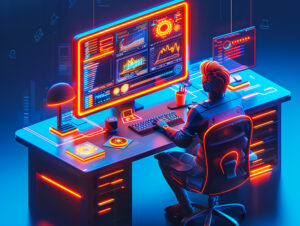My Top 5 Techniques for Web Animation: A Developer’s Guide to Engaging User Experiences
Mastering web animation has become an essential cornerstone of modern web development, transforming static websites into dynamic, interactive experiences that captivate users. Through years of crafting award-winning animations and collaborating with creative agencies, I’ve discovered that the most impactful web animation techniques follow the Pareto Principle – where 80% of stunning visual effects come from mastering just 20% of core animation methods.
The art of web animation continues to evolve rapidly, pushing the boundaries of what’s possible in browser-based interactions. As we delve into these techniques, we’ll explore not just the technical aspects, but also the creative philosophy behind each approach. These methods have proven invaluable across countless projects, from corporate websites to experimental digital experiences.
We strongly recommend that you check out our guide on how to take advantage of AI in today’s passive income economy.
Table of Contents
The Foundation: Scroll Tracking Excellence
Scroll tracking stands as the cornerstone of modern web animation, serving as the foundation for countless interactive experiences. This technique involves monitoring scroll progress within specific page sections, generating values between zero and one that drive sophisticated animations. The beauty of scroll tracking lies in its versatility and ability to create seamless, content-driven animations that respond naturally to user behavior.
In my professional experience, implementing smooth scroll behavior transforms standard web animation implementations into polished, professional experiences. While tools like GSAP’s ScrollTrigger and Framer Motion’s useScroll hook provide robust foundations, the integration of smooth scrolling libraries elevates these animations to new heights. Lenis Scroll and Locomotive Scroll have become industry standards, offering that perfect balance of performance and visual refinement.
Mastering Viewport Detection
The implementation of viewport detection represents a crucial milestone in creating engaging web animation experiences. This technique, fundamental to modern web development, triggers animations precisely when elements enter the user’s viewable area. The sophistication of viewport detection lies in its ability to create perfectly timed animations that enhance the user’s journey through content.
Professional web animation implementations often leverage the Intersection Observer API, though modern frameworks offer more streamlined approaches. The technique’s power lies in its ability to create natural, flowing animations that respond to user scrolling behavior. This approach has become particularly crucial for performance-optimized websites where resource management is paramount.
The Power of Sticky Positioning
Leveraging Native Browser Features
The strategic use of CSS sticky positioning has revolutionized web animation possibilities. This seemingly simple technique opens up a world of creative opportunities when combined with other animation methods. Its native browser support ensures consistent behavior across platforms, making it an invaluable tool in the modern web animator’s arsenal.
The true artistry in using sticky positioning for web animation comes from thinking creatively about its implementation. When properly executed, this technique can create sophisticated animation effects that appear far more complex than their underlying code would suggest. The key lies in understanding how to combine sticky positioning with other animation techniques to create unique, engaging experiences.
The Art of Easing
Creating Emotional Connections Through Motion
Easing functions represent the subtle yet crucial element that can transform good web animation into exceptional ones. The careful selection of easing curves influences the emotional response to animations, creating distinctive website personalities. This technical aspect of animation has become increasingly important as motion design principles continue to integrate more deeply into web development.
The rise of motion design in web development has elevated the importance of mastering easing functions. These mathematical curves define how animations accelerate and decelerate, contributing significantly to a website’s overall feel and professional polish. Understanding and implementing appropriate easing functions has become as crucial as mastering layout and typography.
Typography Animation Through Text Splitting
Breaking Down Content for Dynamic Effects
Text splitting has emerged as a powerful technique in the web animation toolkit, enabling sophisticated typography animations that enhance content presentation. This approach involves deconstructing text elements into manageable components – lines, words, and characters – each becoming an independent animation target. The technique opens up countless possibilities for creative text animations that enhance user engagement.
When implementing text splitting for web animation, careful consideration must be given to accessibility and performance implications. Tools like GSAP’s SplitText module and the SplitType library provide robust foundations for these implementations. The key to success lies in maintaining proper semantic structure while enabling dynamic animation capabilities.
Advanced Techniques and Future Trends
Mathematical Functions in Creative Animation
The implementation of mathematical mapping functions has become increasingly crucial in modern web animation development. These functions transform value ranges, enabling smooth transitions and complex animations that would be difficult to achieve through other means. The technique’s versatility makes it invaluable for creating responsive, dynamic animations that adapt to user interactions.
Linear interpolation (lerp) functions have emerged as essential tools for creating smooth, natural-feeling animations. This mathematical approach enables fluid transitions between states, particularly useful in cursor animations and canvas-based implementations. The technique’s efficiency and simplicity make it a valuable addition to any web animator’s toolkit.
Pushing Boundaries with Shader Animations
The integration of shader-based animations represents the cutting edge of web animation capabilities. While primarily used in experimental and artistic contexts, shaders offer unprecedented control over visual effects and animations. This technique opens up new possibilities for creating unique, memorable user experiences that stand out in today’s digital landscape.
Understanding and implementing shader animations may require additional technical expertise, but the results can be truly extraordinary. As browser capabilities continue to evolve, shader-based web animation techniques will likely become more accessible and widely used, offering exciting possibilities for creative expression in web development.
The landscape of web animation continues to evolve, driven by innovative techniques and growing browser capabilities. These core methods, combined with emerging technologies, provide a robust foundation for creating engaging, professional web experiences. As we look to the future, the continued evolution of these techniques will undoubtedly lead to even more exciting possibilities in web animation and interactive design.

We strongly recommend that you check out our guide on how to take advantage of AI in today’s passive income economy.




